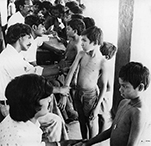Hesperian Health Guides
Leprosy and the Community
HealthWiki > Disabled Village Children > Chapter 26: Leprosy: Hansen’s Disease > Leprosy and the Community
Today, leprosy can be cured—without any deformities or disabilities if treatment is begun early. It can be treated at home. The person can continue going to school or to work. Having leprosy need not disable the person physically or socially.
But in many communities fear and misunderstanding remain. Persons still refuse to admit—even to themselves—the early signs of leprosy. They delay in getting treatment until permanent deformities appear. The disease continues to be spread to others by those who are not yet treated. And so the myth and the fear of leprosy are kept alive.
To correct this situation will require the efforts of all health and rehabilitation workers, schoolteachers, religious and community leaders, families of persons with leprosy, and organizations that serve people with disabilities. These steps are needed:
| 1. Information and Education Schools, health centers, comics, radio, and television can be used to help educate the community about leprosy. Information should: |
|
| 2. Integration of leprosy programs into general health care. Too often leprosy control is done as a separate program. It is important that people (and health workers) begin to see leprosy as “just another serious health problem”— like diarrhea in children. |
 Screening school children for leprosy, India. (Photo, The Leprosy Mission.) |
| 3. Regular screening (mass checkups) of children for skin patches and other early signs of leprosy. This can be part of a CHILD-to-child program (see Chapter 47) in which school children learn first to examine each other, and then their younger brothers and sisters. |
| 4. Community pressure and government orders to let children being treated for leprosy attend school, find work, attend festivals, and take part in public functions. (Organizations of people with disabilities can help make this happen.) |
| 5. Self-help and community groups of people affected by leprosy can raise awareness in the community and increase acceptance, care and respect. They can also organize to get medicines and treatment, and educate to prevent deformity. Where needed, community groups can advocate to get the schooling, health care, work, and social rights that persons with leprosy deserve. |
The example of a health worker who welcomes persons with leprosy and is not afraid to touch them can do much to calm needless fears and encourage acceptance.


